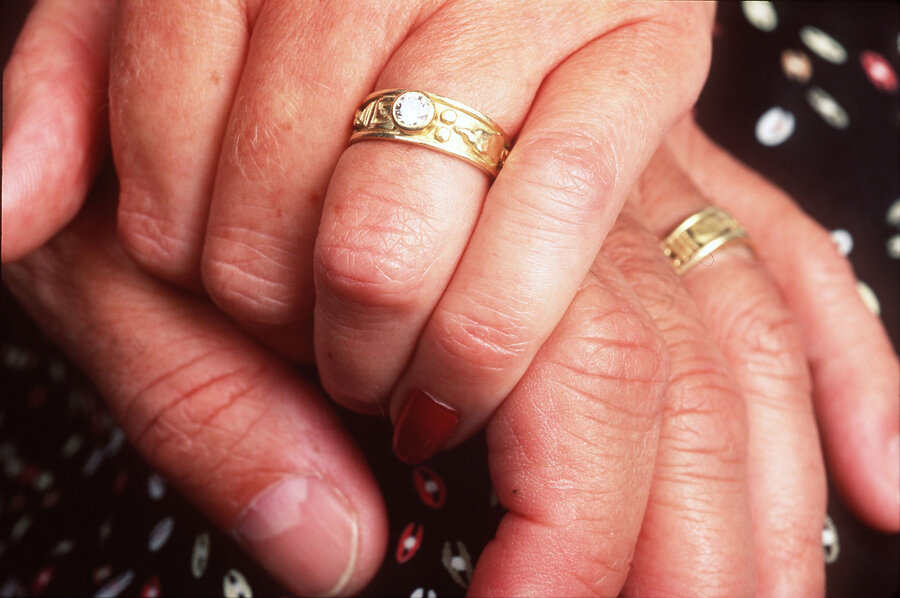Cohabitation before marriage? It's no greater divorce risk.
Loading...
| Atlanta
Nearly half of first marriages break up within 20 years, a new government study finds. With those odds, you might wonder: Would we be better off living together first?
The new research, part of a marriage survey of 22,000 men and women, suggests times have changed from the days when cohabitation before marriage signaled higher chances for divorce later.
"It's not playing as big a role in predicting divorce as it used to," said Casey Copen, lead author of the study "First Marriages in the United States: Data From the 2006–2010 National Survey of Family Growth."
Living together before marriage has been a steady, growing trend.
In the late 1960s, only about 10 percent of American couples moved in together first, and they ended up with higher divorce rates.
Today, about 60 percent of couples live together before they first marry.
"It's becoming so common, it's not surprising it no longer negatively affects marital stability," said Wendy Manning, co-director of the National Center for Family & Marriage Research at Bowling Green State University in Ohio.
Researchers with the Centers for Disease Control and Prevention looked for trends in first marriages. They interviewed men and women ages 15 to 44 during the years 2006 to 2010. About 40 percent were married.
The study found those who were engaged and living together before the wedding were about as likely to have marriages that lasted 15 years as couples who hadn't lived together.
But what about the couples who were living together but weren't engaged? The new study found marriage was less likely to survive to the 10- and 15-year mark among couples who weren't engaged when they lived together – findings similar to earlier research.
For example, for women, there was about a 60 percent likelihood a marriage would survive 15 years if the couple either hadn't lived together before the wedding or were engaged while they were sharing the same living space. But if no firm marriage commitment was made while she and her boyfriend were living together, the likelihood the marriage would last 15 years fell to 53 percent. The numbers were similar for men.
Potential explanations include more lax attitudes about commitment, lower education levels or family histories that made these couples more pessimistic about marriage, Copen said.
The experience of living together before marriage is different for different people, said Richard Settersten Jr., an Oregon State University professor of human development and family science.
Some young people put off marriage because they're pursuing a college education and starting a career. For them,"cohabitation is a trial marriage, usually without kids, that often ends in marriage," Settersten said.
Others – in many cases, people not on a college track – move from one living-together relationship to another, some of them producing children, he said.
Commitment has made a difference. In interviews with some women who have been married 20 years or more after living with their spouse first, firm belief in a future together was a common theme.
"I sort of knew he would be part of my life long-term.... I wasn't thinking, 'He's moving in with me, is he ever going to marry me?'" said Hillary Mickell, a San Francisco woman who first moved in with her husband when they were students at Boston University.
But this was in 1985, and she did try to hide their situation from her parents in California, sometimes telling them her beau answered the phone because there had been a snowstorm and he was stuck in her apartment. "It became a running joke – there are blizzards in Boston nine months a year," said Mickell, co-founder of a social network site for recipe exchanges.
The CDC study also concluded:
– Nearly half of first marriages will break up within 20 years – a statistic identical to what other studies have found.
– The percentage of young women currently living with a male partner grew from 3 percent in 1982 to 11 percent recently.
– Women and men with bachelor's degrees were more likely to delay marriage but also more likely to eventually get married and stayed married for at least 20 years.
– Asian women were the most likely to be in a first marriage that lasted at least 20 years. Nearly 70 percent of Asian women were still in their first marriage, compared to 54 percent of white women, 53 percent of Hispanic women and 37 percent of black women.
Among men, 62 percent of Hispanics were still in their first marriage at 20 years, compared to 54 percent of whites and 53 percent of blacks. The study did not have statistics for Asian men.







